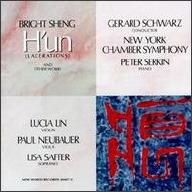Born December 6, 1955 in Shanghai, Sheng began his musical training when he was four years of age with piano lessons from his mother and later from a private teacher. Sheng was 11 when the Revolution began in 1966. As there were few jobs available, many young people were sent to the country to live and work with the rural peasant class. He was sent to Qinghai in western China and received a three-year contract with a song-and-dance troupe with whom he played piano.
Sheng's formal musical education resumed after the end of the Cultural Revolution in 1976, with entrance into the Shanghai Conservatory of Music, where he earned his undergraduate degree. The Cultural Revolution and the time he spent in Qinghai proved to be major influences on Sheng's music. Sheng composed H'un (Lacerations): In Memoriam 1966-1976 and China Dreams based on experiences from the Cultural Revolution. Other pieces, such as the opera Song of Majnun and Two Folk Songs from Qinghai, are based on folk songs learned while he was in Qinghai. Sheng is also influenced by the Hungarian composer Béla Bartók, who himself used folk music elements in his compositions.
Bright Sheng is professor of music at the University of Michigan; he contributed to Yo-Yo Ma's Silk Road Project, which took him back to China in the summer of 2000.
Sheng's music has gained far wider public exposure than that of most of his academic compatriots. He has continued to excel in the operatic field with The Silver River (1997, co-commissioned by Kennedy Center, and subsequently performed in many places), Madam Mao (2003), and Dream of the Red Chamber (2016), which quickly sold out its entire run at the San Francisco Opera. His instrumental music is abundantly available on recordings. Often Sheng has continued to explore Chinese folk traditions, combining them with Western techniques and textures. A notable example was The Singing Gobi Desert, a nonet for erhu/zhonghu, sheng, pipa, yangqin, saxophone quartet, and percussion. In several pieces he has used a marimba, an instrument neither Chinese nor Western. Sheng's composition Northern Lights, recorded in 2017 for Naxos, broke what was perhaps new ground for a Chinese-born composer: it took a Western folk tradition, that of the Norwegian hardanger fiddle, as its basis. Sheng has said that he considers himself "100 percent Chinese and 100 percent Western." ~ Bruce Lundgren & James Manheim, Rovi

















